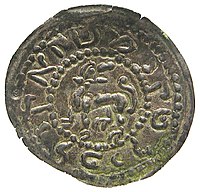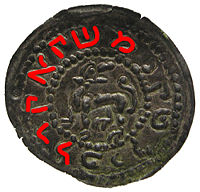Knaanic language
| Knaanic | |
|---|---|
| Region | Europe |
| Extinct | Late Middle Ages |
| Language codes | |
| ISO 639-3 | czk[note 1] |
| Glottolog | west3000 |
Knaanic (also called Canaanic, Leshon Knaan, Judaeo-Czech, Judeo-Slavic) is a tentative name for a number of
Etymology
The name comes from the "land of Knaan", a geo-ethnological term denoting the Jewish populations living principally in Czechia, though sometimes applied to all Jewish populations east of the
The term is derived from ancient
History
The language became extinct some time in the
Coinage
A possible early example of Knaanic is a 9th-century letter for a Jewish community of
The reason that Knaanic inscriptions, which use Hebrew letters, appear on coins minted for a Polish duke is that at the time, he leased some mints to Jews. The mint masters were responsible for collecting bullion and striking coins as well as periodically taking in and restriking existing coins.[10]
The inscriptions on the coins range widely. Some are Hebrew names, possibly those of the mintmasters. Some are the names of the towns in which the mint operated, for instance Kalisz, the burial place of Mieszko the Old. Some have the duke's name. One in the National Bank of Poland's numismatic collection bears the word bracha, Hebrew for blessing.[10]
| Inscription (Knaanic) | משקא קרל פלסק |
| Transcription | mškʾ krl plsk |
| Interpretation (Polish) | Mieszko, król Polski |
| Translation | ' Mieszko , king of Poland'
|
Classification
In the 15th edition of Ethnologue (2005) assigned code czk to it and said that the term Knaanic is used primarily for Jewish Czech, possibly also for other Jewish variants of West Slavic languages, extinct in the Middle Ages. The 16th edition (2009) no longer lists Knaanic among the West Slavic languages. It mentioned it only as an "extinct or artificial" language without further specification and refers to the Linguist List portal.
As of 2023[update] Ethnologue once again lists Knaanic as a Czech–Slovak language.[11]
See also
- Judaeo-Spanish (Ladino)
Notes
- ^ The iso639-3 page for czk has no information on the language. It refers to Ethnologue, Glottolog, Multitree, but only Ethnologue currently defines czk.
References
- ^ Uličná, Lenka, "Roman Jakobson a staročeské glosy ve středověkých hebrejských spisech". Bohemica Olomucensia 3 – Filologica Juvenilia. Olomouc 2009, pp. 13-24,
- ^ Uličná, Lenka, "Hlavní proudy středověkého (pre)aškenázského myšlení a tzv. pražská komentátorská škola. Hledání identity v podmínkách izolace a integrace". In: Jiřina Šedinová et al, Dialog myšlenkových proudů středověkého judaismu, Praha, 2010
- ^ ISBN 83-223-2095-7.
- ISBN 978-0-300-10887-3.
- ISBN 3-11-017258-5.
- .
- ^ for instance Max Weinreich (1956). "Yiddish, Knaanic, Slavic: The basic relationships". For Roman Jakobson: Essays on the occasion of his sixtieth birthday, 11 October 1956. The Hague: Mouton. pp. 622–632.
- ^ History of the Yiddish Language, op.cit., pp. 727
- ^ "Rashi on Deuteronomy 3:9:2".
- ^ a b Bankoteka, p.25.
- ^ "Indo-European - Ethnologue Free". Ethnologue. SIL International. Archived from the original on 2023-05-22. Retrieved 2023-05-21.
Literature
- Bondyová, Ruth (2003). Mezi námi řečeno. Jak mluvili Židé v Čechách a na Moravě [Between us: language of Jews in Bohemia and Moravia] (in Czech). Society of Franz Kafka]. ISBN 80-85844-88-5. The book documents languages used by Jews in the Czech lands during 12–20th century. Reviewin Czech, pages 28–33.
- (In Czech) Šedinová, Jiřina: "Literatura a jazyk Židů v Českých zemích", in EUROLITTERARIA & EUROLINGUA 2005, Technická univerzita v Liberci, Liberec 2005. Jiřina Šedinová from the Charles University in Prague seems to be the only specialist to study the glosses written in leshon kenaan which appear in some Jewish religious texts from Bohemia. In this article the author affirms leshon kenaan is just the Hebrew term for the local Slavic language.
- ISBN 0-226-88604-2
External links
 Media related to Knaanic language at Wikimedia Commons
Media related to Knaanic language at Wikimedia Commons


